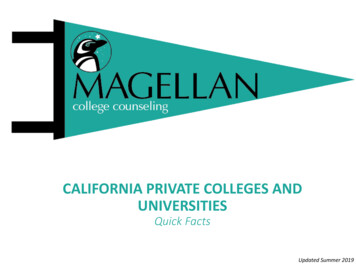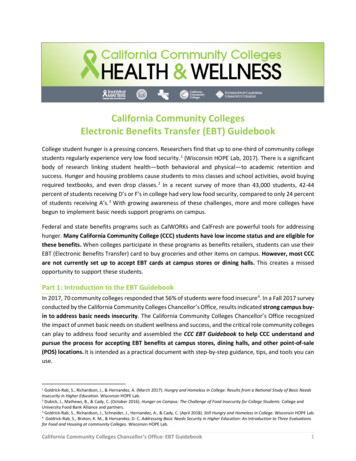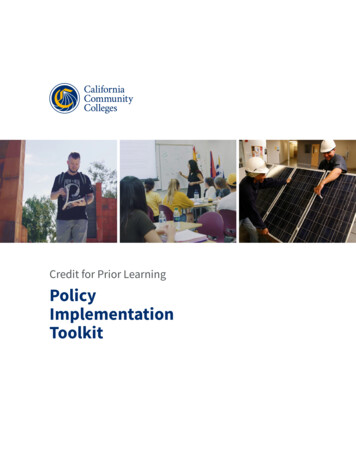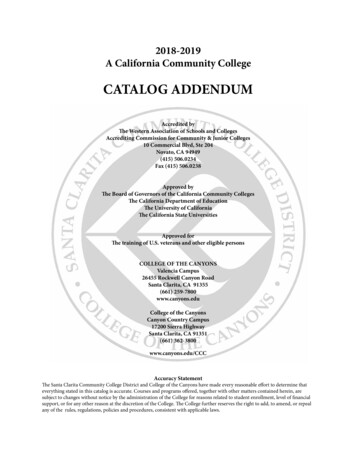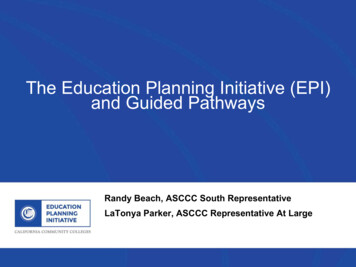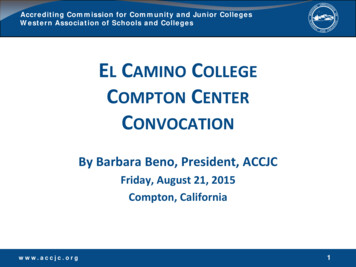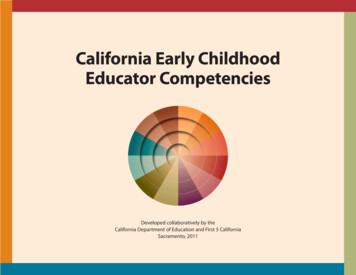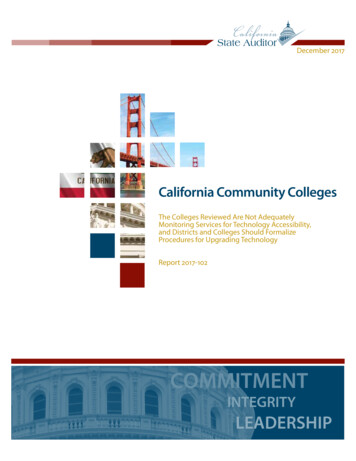
Transcription
December 2017California Community CollegesThe Colleges Reviewed Are Not AdequatelyMonitoring Services for Technology Accessibility,and Districts and Colleges Should FormalizeProcedures for Upgrading TechnologyReport 2017-102COMMITMENTINTEGRITYLEADERSHIP
CALIFORNIA STATE AUDITOR621 Capitol Mall, Suite 1200 Sacramento CA 95814916.445.0255 TTY 916.445.0033For complaints of state employee misconduct,contact us through the Whistleblower Hotline:1.800.952.5665Don’t want to miss any of our reports? Subscribe to our email list atauditor.ca.govFor questions regarding the contents of this report, please contact Margarita Fernández, Chief of Public Affairs, at 916.445.0255This report is also available online at www.auditor.ca.gov Alternate format reports available upon request Permission is granted to reproduce reports
Elaine M. Howle State AuditorDoug Cordiner Chief DeputyDecember 5, 20172017-102The Governor of CaliforniaPresident pro Tempore of the SenateSpeaker of the AssemblyState CapitolSacramento, California 95814Dear Governor and Legislative Leaders:As requested by the Joint Legislative Audit Committee, the California State Auditor presentsthis audit report concerning the California Community Colleges’ monitoring of services fortechnology accessibility and the procedures for upgrading information technology (IT).This report concludes that the three community colleges we reviewed are not adequatelymonitoring their performance in responding to requests from students with disabilities forcourse materials in accessible media formats, and one has not established a goal for howlong it should take to process these requests. Additionally, the Office of the Chancellor of theCalifornia Community Colleges (Chancellor’s Office) has not provided guidance to communitycolleges on monitoring their compliance with accessibility standards. As a result, the collegescannot demonstrate that they are meeting students’ requests for accessible materials withina reasonable time frame. When students do not have equal access to instructional materialsand their requests for an alternate format are not addressed promptly, they do not have equaleducational opportunities.Although the colleges and related districts we reviewed have some processes and tools forreplacing and upgrading their IT equipment, none of them have formalized these processesto ensure consistency and continuity in the future. Additionally, the Chancellor’s Office doesnot provide guidance to all of the colleges and districts related to upgrading or replacing ITequipment. We also noted that college instructional departments could not consistently providedocumentation showing the stakeholder input received when deciding on what IT to replaceor upgrade. Without formalizing their processes by documenting procedures for instructionaldepartment staff to follow when making decisions on technology equipment, the communitycolleges cannot ensure that these processes are consistently followed and are transparent.Respectfully submitted,ELAINE M. HOWLE, CPAState Auditor621 Capitol Mall, Suite 1200S a c r a m e n t o, C A 9 5 8 1 4916.445.0255916.327.0019 faxw w w. a u d i t o r. c a . g o v
ivReport 2017-102 C ALIFO R N IA S TAT E AUD I TO RDecember 2017Selected Abbreviations Used in This ReportACCICAccrediting Commission for Community and Junior Colleges, Western Association ofSchools and CollegesADAAmericans with Disabilities ActAmerican RiverAmerican River CollegeCerritosCerritos Community College [a single-college district]De AnzaDe Anza CollegeDSPSDisabled student programs and servicesFoothill–De AnzaFoothill–De Anza Community College DistrictLos RiosLos Rios Community College District
C ALIFO R N IA S TAT E AUD I TO R Report 2017-102December 2017CONTENTSSummary1Introduction5Community Colleges Are Not Adequately Monitoring ComplianceWith Accessibility Standards, and the Chancellor’s Office ShouldProvide Additional Guidance to Assist Community Colleges inSupporting Students With Disabilities13Community College Districts Plan for and Fund IT Needs but LackWritten Procedures to Guide Their Processes27Scope and Methodology47Responses to the AuditCalifornia Community Colleges Chancellor’s Office51Cerritos Community College District53California State Auditor’s Comment on the Response FromCerritos Community College DistrictFoothill–De Anza Community College DistrictCalifornia State Auditor’s Comments on the Response FromFoothill–De Anza Community College DistrictLos Rios Community College DistrictCalifornia State Auditor’s Comments on the Response FromLos Rios Community College District5961676973v
viReport 2017-102 C ALIFO R N IA S TAT E AUD I TO RDecember 2017Blank page inserted for reproduction purposes only.
C ALIFO R N IA S TAT E AUD I TO R Report 2017-102December 2017SUMMARYTo educate students in an environment in which technology is continually changing,community colleges need to have long‑term plans, as well as plans for periodicallyreplacing and upgrading information technology (IT) equipment and support structures.Community colleges must also address the needs of students with disabilities to accesswebsites and other technology as well as class materials. Federal and state accessibilitylaws require colleges to make all class materials available, upon request, in a format thatis accessible to students with disabilities, and to ensure that websites meet guidelinesfor accessibility.California’s community colleges are required to plan for IT needs as part of theiraccreditation process. The foundation of these efforts is a technology master planthat identifies technology needs at the college. These needs may relate to technologyinfrastructure—items such as networking devices and devices that enable wirelesscommunication, that allow the colleges to transmit information, and that support thegeneral operations of the campuses. Colleges also need instructional technology, such aslaptop computers in math labs, to support student learning.For this audit, we reviewed three community college districts: Foothill–De AnzaCommunity College District (Foothill–De Anza), Los Rios Community College District(Los Rios), and Cerritos Community College (Cerritos), a single‑college district. In addition,we reviewed one individual college within each of the multicollege districts: De AnzaCollege (De Anza) in Foothill–De Anza and American River College (American River)in Los Rios. Specifically, we reviewed the colleges’ compliance with federal and stateaccessibility standards. We also reviewed the colleges’ and districts’ processes for upgradingand replacing IT equipment, including their planning processes and financing. This reportdraws the following conclusions:Community colleges are not adequately monitoring compliancewith accessibility standards, and the Chancellor’s Office shouldprovide additional guidance to assist community colleges insupporting students with disabilities.None of the three community colleges we reviewed are monitoringtheir performance in responding to requests from students withdisabilities for course materials in accessible media formats(alternate media), and one college has not established a goal forhow long it should take to process these requests. These collegesalso do not have processes to monitor whether they comply withaccessibility standards for instructional materials, nor has theOffice of the Chancellor of the California Community Colleges(Chancellor’s Office) provided guidance to the colleges in either ofthese areas because it has focused its guidance in other areas andhas limited staffing. As a result, the colleges cannot demonstratethat they are meeting students’ requests for accessible materialswithin a reasonable time frame. When students do not havePage 131
2Report 2017-102 C ALIFO R N IA S TAT E AUD I TO RDecember 2017equal access to instructional materials and their requests for analternate format are not addressed promptly, they do not have equaleducational opportunities.Page 27Community college districts plan for and fund IT needs but lackwritten procedures to guide their processes.The three community college districts and colleges we reviewedhave some processes and tools for replacing or upgrading theirtechnology equipment. However, they have not formalized theseprocesses to ensure consistency and continuity in the future. TheChancellor’s Office does not provide guidance to all of the communitycollege districts and colleges related to upgrading or replacingIT equipment. Additionally, each of the districts and collegesreviewed has a technology master plan, but Cerritos’ plan is not upto date and does not include detailed steps to implement its masterplan. American River also lacks steps to implement its master plan.Further, college instructional departments could not consistentlyprovide documentation showing the stakeholder input received whendeciding on what information technology to replace or upgrade.Without formalizing their processes by documenting proceduresfor instructional department staff to follow when making decisionson IT equipment, the community colleges cannot ensure thatthese processes are consistently followed and are transparent. TheChancellor’s Office provided some guidance on implementingdecision‑making processes. However, this guidance does not addressdocumentation of input, attendees, or agreements reached at collegegovernance or department meetings, including those to considertechnology equipment requests. Lastly, the colleges offer technologytraining and assistance to faculty, staff, and students and variousopportunities for these stakeholders to provide input on technologytraining needs.
C ALIFO R N IA S TAT E AUD I TO R Report 2017-102December 2017Summary of RecommendationsChancellor’s Office To ensure that all community colleges are complying withtimeliness requirements, by June 2018, the Chancellor’s Officeshould establish guidance for the colleges on monitoring theireffectiveness in responding to students’ requests for instructionalmaterials in alternate media formats in a timely manner. At aminimum, this guidance should provide direction to communitycolleges on establishing a time‑frame goal for completing studentrequests and on establishing procedures to periodically monitortheir performance in meeting those goals. To ensure that students with disabilities have equal access toinstructional materials, by June 2018, the Chancellor’s Officeshould develop guidance for the community colleges onperiodically monitoring the accessibility of instructional materials. To assist all community college districts and colleges inensuring that they have consistent, transparent, and continuousimplementation of their processes for upgrading and replacingIT equipment, by September 2018, the Chancellor’s Officeshould issue guidance to the districts and community colleges onestablishing written procedures for those processes. To assist all community colleges in increasing transparencyof their decision‑making processes, by September 2018, theChancellor’s Office should issue guidance to the communitycolleges on establishing procedures to document the attendees,input received, and agreements reached during departmentmeetings, including those to consider IT equipment requests.Community Colleges and Districts To ensure that they are fulfilling requests for alternate mediaservices from students with disabilities in a timely manner,by June 2018, American River, Cerritos, and De Anza shouldeach establish procedures for monitoring their timeliness inresponding to such requests so that they can periodically reviewtheir performance in completing the requests. Additionally, toevaluate its performance, De Anza should establish a time‑framegoal for completing alternate media requests.3
4Report 2017-102 C ALIFO R N IA S TAT E AUD I TO RDecember 2017 To ensure that students with disabilities have equal access toinstructional materials, by June 2018, American River, Cerritos,and De Anza should each develop procedures to monitor andperiodically review the accessibility of instructional materials. To ensure the consistent, transparent, and continuousimplementation of processes for technology equipmentupgrades and replacements, by June 2018, Cerritos, Los Rios,and Foothill–De Anza districts, and American River should eachestablish written procedures for these processes. To ensure that it fully implements its technology master plan, byJune 2018, American River should establish an implementationplan with detailed steps for achieving the goals in its master planthat it has not yet accomplished. Also, by June 2018, Cerritosshould update its technology master plan, including detailedsteps to accomplish its master plan goals. To increase the transparency of their annual review processes,by June 2018, American River, Cerritos, and De Anza shouldestablish procedures to document a summary of the inputeach receives and agreements reached during meetings toconsider instructional IT requests.Agency CommentsThe Chancellors Office, Cerritos, and Foothill–De Anza agreedwith our recommendations. Los Rios agreed with several ofour recommendations and indicated that it plans to undertakesteps to implement them. However, it disagreed with ourrecommendation to include a requirement in its next collectivebargaining negotiations for instructors to periodically attendaccessibility trainings.
C ALIFO R N IA S TAT E AUD I TO R Report 2017-102December 2017INTRODUCTIONBackgroundThe Office of the Chancellor of the California Community Colleges(Chancellor’s Office) reports that the California CommunityColleges is the largest system of higher education in the nation,with more than 2.3 million students attending its 113 colleges in the2016–17 academic year. The Board of Governors for the CaliforniaCommunity Colleges sets policy and provides guidance to itscolleges, which are organized into 72 community college districts.The community college districts each have a locally elected boardof trustees charged with the operations of the local colleges. Thecolleges operate under a system of shared governance. Intended toensure that faculty, staff, and students have the right to participateeffectively in district and college governance, shared governanceconsists of procedures established by districts’ governing boards togive these stakeholders the opportunity to express their opinions atthe campus level and to ensure that their opinions are given everyreasonable consideration. For example, the districts and collegeswe reviewed use shared governance committees, such as budget ortechnology committees made up of faculty, staff, and students.This audit focuses on the community college districts’ processesfor replacing and upgrading information technology (IT)equipment. To educate students in an environment in whichtechnology is continually changing, it is important to develop bothlong‑term plans and ongoing plans for replacing and upgradingIT equipment. The State’s 72 community college districts varyin size and composition, with 49 of the districts consisting of asingle college and the remaining 23 districts containing two ormore colleges. The multicollege districts average three colleges buthave as many as nine. For this audit, we selected three districts thatreflect this diversity in size as well as geography. Specifically, wereviewed two multicollege districts—Foothill–De Anza CommunityCollege District (Foothill–De Anza) in the Bay Area and Los RiosCommunity College District (Los Rios) in Northern California—and one single‑college district from Southern California, CerritosCommunity College (Cerritos). Los Rios includes four colleges,and Foothill–De Anza has two colleges.College Accreditation ProcessState regulations require each community college to be anaccredited institution. The Accrediting Commission forCommunity and Junior Colleges, Western Association of Schoolsand Colleges (ACCJC), is the accrediting agency for the communitycolleges in California. According to ACCJC’s Manual for5
6Report 2017-102 C ALIFO R N IA S TAT E AUD I TO RDecember 2017Institutional Self‑Evaluation, accreditation is a system for regulatingthe quality of higher education by evaluating educational qualityand institutional effectiveness on a regular basis. In its manual,ACCJC states that its accreditation process provides assurance tothe public that the accredited member colleges meet accreditationstandards of quality, that the education earned at the colleges is ofvalue to the student who earned it, and that employers, trade‑ orprofession‑related licensing agencies, and other colleges anduniversities can accept students’ credentials as legitimate. Further,accreditation is one of the requirements for community colleges tobe eligible to receive federal aid, including grants for students.ACCJC directs the accreditation process for the CaliforniaCommunity Colleges, a process that includes several componentsof evaluation and review. According to ACCJC’s manual, accreditedinstitutions participate in a comprehensive review for reaffirmationof accreditation once every seven years. As part of the review,institutions complete a self‑evaluation and undergo an externalevaluation by a team of peer evaluators. These teams conducta review following completion of institutional self‑evaluationsto determine the extent to which an institution meets ACCJC’sstandards. After the review, the teams of peer evaluators makerecommendations for compliance and improvement that willhelp the college better meet ACCJC’s standards. The teams alsocommend excellent practices when appropriate and provide boththe college and ACCJC with a report of their findings.ACCJC has standards that cover a wide variety of college activities,including several related to IT. As shown in Figure 1, ACCJC hasfour general categories of accreditation standards, and within theresources category are standards that directly relate to IT.1 Ourreview of districts focused on some of the standards associated withresources and leadership and governance. These included standardsinvolving policies and procedures that guide training in the use oftechnology, as well as ones involving planning for upgrades andreplacements to technology.1Because the colleges we reviewed were most recently accredited by ACCJC under the June 2012standards, we include those standards in Figure 1. ACCJC published updated standards in 2014,and the revised standards became the basis for comprehensive institutional evaluations forreaffirmation of accreditation beginning in spring 2016.
C ALIFO R N IA S TAT E AUD I TO R Report 2017-102December 2017Figure 1Relevant ACCJC Accreditation Standards in Effect for the Most Recent Accreditation Reviews of Selected CollegesI Institutional Missionand EffectivenessAREAS OFII Student LearningProgram and ServicesACCREDITATIONSTANDARDSIII ResourcesI V Leadership andGovernanceThe institution establishes and implements a writtenpolicy providing for faculty, staff, administrator, andstudent participation in decision-making processes.The policy specifies the manner in which individualsbring forward ideas from their constituencies andwork together on appropriate policy, planning,and special-purpose bodies. Faculty and administrators have a substantiveand clearly defined role in institutionalgovernance and exercise a substantial voice ininstitutional policies, planning, and budget thatrelate to their areas of responsibility andexpertise. Students and staff also haveestablished mechanisms or organizations forproviding input into institutional decisions.Source: Selected 2012 ACCJC Accreditation Standards that apply to this audit.The institution assures that any technology support itprovides is designed to meet the needs of learning,teaching, collegewide communications, research, andoperational systems. The institution provides quality training in theeffective application of its IT to students andcollege personnel. The institution systematically plans, acquires,maintains, and upgrades or replaces technologyinfrastructure and equipment to meetinstitutional needs.7
8Report 2017-102 C ALIFO R N IA S TAT E AUD I TO RDecember 2017Types of Campus IT and State Funding for Community College DistrictsAs part of their mission to educate students, community collegesacquire IT equipment. We determined that this IT equipment falls intotwo categories: technology equipment supporting the infrastructure ofcolleges and districts and instructional technology equipment supportingstudent learning. Infrastructure technology equipment includes itemsused throughout the college, such as computers for faculty and staff andnetworking equipment such as printers, switches, and Wi‑Fi devices.These items enable the colleges to receive and transmit information andsupport the general operations of the campus. In contrast, instructionaltechnology equipment is installed for classroom purposes or for use byspecific instructional departments, such as laptop computers for studentsin math labs and specialized printers.The community college system in California is supported by an allocationof funding through the State’s annual budget process. State law requiresthe Board of Governors to prepare and adopt an annual statewide budgetproposal, which includes funding for state operations of the Chancellor’sOffice and local assistance funding for the community college districts.For fiscal year 2016–17, the Board of Governors’ budget request identifiedseveral priorities, such as increased funding for general operating and ITexpenses and to hire more full‑time faculty. The Legislature appropriatedmore than 4.6 billion in local assistance funds for the communitycollege districts, consisting of general apportionments of 3.1 billionfor the districts and 1.5 billion for categorical programs to accomplishspecific program objectives. According to the Chancellor’s Office’sdeputy chancellor, the majority of these categorical funds are allocated todistricts for local program implementation, but roughly 100 million isdirected to statewide initiatives that the Chancellor’s Office manages inpartnership with lead districts. This amount did not include a specifiedallocation for IT from the district apportionments, but it did includefunding for IT projects directed by the Chancellor’s Office. For example,the Legislature appropriated nearly 28 million for telecommunicationsand technology infrastructure. We discuss an example of these projectsin greater detail in the Audit Results.Accessibility LawTo address the needs of individuals with disabilities, the federalgovernment enacted the Rehabilitation Act of 1973 (RehabilitationAct). The Rehabilitation Act states that no otherwise qualifiedindividual with a disability shall, solely by reason of his or herdisability, be excluded from participating in, be denied the benefitsof, or be subjected to discrimination under any program or activityreceiving federal assistance. As recipients of federal assistance,California’s community colleges are subject to the provisions of theRehabilitation Act. In 1990 the federal government reinforced its
C ALIFO R N IA S TAT E AUD I TO R Report 2017-102December 2017commitment to individuals with disabilities by enacting the Americanswith Disabilities Act (ADA), which provides individuals with disabilitiescivil rights protection and places emphasis on providing them withequal opportunity. Specific provisions of both the Rehabilitation Actand the ADA apply to programs and activities provided by publicentities, including California’s community colleges.In 1998 Congress enacted Section 508 of the Rehabilitation Act(Section 508), which requires federal agencies to make electronic and ITaccessible to individuals with disabilities. The law applies to federalagencies when they develop, procure, maintain, or use electronic and IT.Under Section 508, agencies must provide individuals with disabilitiesaccess to and use of information and data that are comparable to theaccess to and use of the information and data available to others. In 2002the California Legislature amended state law to make the requirementsof Section 508 applicable to public entities in California. BecauseCalifornia’s community colleges are public entities, they must complywith the provisions of the Rehabilitation Act, the ADA, and Section 508.Additionally, the Architectural and Transportation Barriers ComplianceBoard, an independent federal agency that develops guidelines andstandards for accessibility, published in January 2017 anupdate to the requirements for information andExamples of Services That Can Be Providedcommunication technology covered by Section 508. Inby DSPS Officespart, the updated requirements are intended to clarify thetypes of internal or nonpublic electronic content that Access to adaptive educational equipment, materials,agencies must make accessible, including electronicand supplies.educational materials. By January 2018, agencies will be Assessment for learning disabilities.required by federal law to apply accessibilitystandards to all information and communication Facilitation of test taking, including adapting tests for andproctoring test taking by disabled students.technologies that they develop, purchase, maintain, or use,such as video, audio, web services, and software Interpreter or captioning services for hearing-impaired orprograms (instructional materials).deaf students.Disabled student programs and services (DSPS) officesat California community colleges provide supportservices and educational accommodations to studentswith disabilities so that they can equally participate inand benefit from the college educational experience. Asdefined in state guidelines published by the Chancellor’sOffice, the terms alternate media and accessible formatsrefer to methods of making information accessible topersons with disabilities. For example, DSPS offices canprovide audio versions of textbooks to students withvisual impairments. Additionally, colleges can providespecialized instruction or counseling as part of theirDSPS programs. Examples of DSPS services areincluded in the text box. According to Chancellor’sOffice data, more than 120,000 students with disabilitiesattended California community colleges during the Job placement and development services related totransitioning from school to employment. Mobility assistance. Note-taking and manual manipulation forclassroom activities. Registration assistance. Specialized counseling. Specialized instruction. Specialized tutoring. Transcription services , including Braille and print materials.Source: Education Code, section 67311.9
10Report 2017-102 C ALIFO R N IA S TAT E AUD I TO RDecember 20172015–16 academic year. These students have disabilities such as visualimpairments, mobility impairments, hearing impairments, andpsychological disabilities.Website AccessibilityLevels of Noncompliance With WebsiteAccessibility GuidelinesFederal regulations implementing Section 508incorporate standards that ensure access toLevel A: Instances that a web content developer mustonline services for persons with disabilities,satisfy; otherwise, one or more groups will find it impossiblebased on the World Wide Web Consortium’sto access the information.Web Content Accessibility Guidelines (webaccessibility guidelines). The consortium is anLevel AA: Instances that a web content developer shouldinternational community that develops opensatisfy; otherwise, one or more groups will find it difficult toaccess the information.standards to ensure long‑term growth of theweb. The guidelines present three levels thatLevel AAA: Instances that a web content developerdescribe, in descending order from most severemay address; otherwise, one or more groups will find itto least severe, the effects of not complyingsomewhat difficult to access information.with the standards, as shown in the text box.Source: Web accessibility guidelines.Colleges and universities nationally, includingHarvard University, Massachusetts Instituteof Technology, Princeton University, and theUniversity of California, Berkeley, have been subject to lawsuitsand compliance reviews resulting from difficulties experienced bystudents with disabilities in accessing their respective web and ITresources. Further, in September 2015, a California communitycollege settled a lawsuit with a student alleging discriminationbecause of a lack of accessibility in the college’s online instructionalplatform and related course materials. The district settled this casefor 40,000 plus the plaintiff ’s legal fees and agreed to take certaincorrective actions.Chancellor’s Office Accessibility ActivitiesState law requires the Board of Governors to develop andimplement a system for evaluating state‑funded programsand services for disabled students on each campus at least everyfive years. At a minimum, these systems are to provide forthe gathering of outcome data, staff and student perceptionsof program effectiveness, and data on the implementation ofthe program and the physical accessibility requirements of theRehabilitation Act. Additionally, state law requires that everytwo years the Board of Governors submits a report to the Governor,the Legislature’s education policy committees, and the CaliforniaPostsecondary Education Commission describing its efforts to servestudents with disabilities. We discuss the most recent report later inthis report.
C ALIFO R N IA S TAT E AUD I TO R Report 2017-102December 2017State law also assigns statewide responsibility for reviewing andapproving all new educational programs in the community collegesto the Board of Governors. The Board of Governors has delegatedthese responsibilities to the academic affairs division of theChancellor’s Office. To meet these responsibilities, the Chancellor’sOffice developed the California Community Colleges CurriculumCommittee (Curriculum Committee), w
Los Rios Community College District 69 California State Auditor's Comments on the Response From Los Rios Community College District 73. vi Report 2017-102 CALIFORNIA STATE AUDITOR December 2017 Blank page inserted for reproduction purposes only. CALIFORNIA STATE AUDTOR Reort 017-102 1



